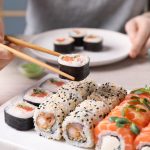Radioactive fish, anyone? U.S. defies global concerns with Fukushima seafood
 (NaturalHealth365) The 2011 Fukushima nuclear power plant disaster was horrific for the people of Japan, causing widespread injury and death. One of the main issues with nuclear disasters, in general, is the persistence of contamination; sites like Fukushima and Chernobyl will be radioactive for hundreds of years. While the Japanese government and nuclear technicians have worked to contain the contaminated water, they are quickly running out of room and so, with the help of a purification company, have begun releasing large volumes of treated water from Fukushima into the Pacific Ocean.
(NaturalHealth365) The 2011 Fukushima nuclear power plant disaster was horrific for the people of Japan, causing widespread injury and death. One of the main issues with nuclear disasters, in general, is the persistence of contamination; sites like Fukushima and Chernobyl will be radioactive for hundreds of years. While the Japanese government and nuclear technicians have worked to contain the contaminated water, they are quickly running out of room and so, with the help of a purification company, have begun releasing large volumes of treated water from Fukushima into the Pacific Ocean.
While the people involved in treating and releasing this decontaminated water assure the world community that the water is safe, there is a growing body of opposition to these controlled, regular discharges of nuclear-irradiated water. Marine biologists, health professionals, government professionals, and other scientists across the world have raised the alarm about the safety of water being released directly into the ocean, specifically how it affects the fish near Japan that is served as food for humans.
We’ll examine the process of treating nuclear water, the primary concerns of those opposing these discharges, and what you can do to protect yourself.
What are the risks of Fukushima-irradiated water?
The technicians at the nuclear power facility in Fukushima that was destroyed by the tsunami in 2011 have been flooding the core with seawater in an effort to keep it stable and cool. The massive earthquake and resulting tsunami disabled the nuclear plant’s cooling systems so this is a reasonable solution to preventing total meltdown.
With that said, however, the core itself is highly radioactive, and as the water passes through, it is filled with tritium, strontium-90, and celsium-137. The companies that are working with the Japanese government to remove these radioactive particles from the water have demonstrated a decent ability to get the radiation levels present within or under international standards for safety.
Once the water has been treated, it is sent to underground vats for storage. However, the Japanese government is running out of space, so they have been discharging massive amounts of it at regular intervals into the Pacific.
Treated water doesn’t mean pure
One major concern is the bioaccumulation of various types of radiation, such as tritium. This phenomenon means that even small radiation doses gradually accumulate in the bodies of organic organisms like fish, plants, and humans over time. Similar to mercury, this accumulated radiation can have harmful effects as it builds up.
Opponents of the water disposal practice cite this bioaccumulation as a key reason to halt the process until further research is conducted. Moreover, radiation can accumulate rapidly in fish destined for human consumption. Predatory fish like tuna, which feed on smaller fish, experience a significant increase in radiation levels due to the bioaccumulation from their prey. This parallels the caution advised against consuming large fish due to mercury accumulation.
Critics also argue that insufficient research has been conducted on the purification process itself. While the water’s radiation levels may fall below acceptable standards, they still remain significantly higher than normal seawater levels, potentially affecting the safety of seafood consumption.
American complacency with radiated fish
One of the biggest issues is that the U.S. military just signed a contract with the Japanese government to buy massive amounts of Japanese seafood. A large part of this is because Japan is one of our closest allies and one of our strongest allies in the Pacific region, and South Korea, China, and Russia all banned imports of Japanese fish, causing an economic problem for Japan.
The U.S. government does not have a great track record of protecting citizens when it comes to companies putting profit over preventing poison in the food supply. If you need proof, just look at the lackluster efforts to completely ban toxic herbicides.
How to protect yourself from irradiated seafood
One of the easiest things that you can do to prevent exposure to Fukushima fallout water in your food is to ensure that it was caught someplace other than Japan. Unfortunately, if you are in the military, you are probably stuck eating Japanese seafood due to the contracts signed by the United States government. If you have the ability to opt for wild-caught Alaskan seafood or any wild-caught fish from a region that is far from Japan, that’s probably your safest bet.
Even if you do not eat seafood itself, you may not be in the clear. Japan exports quite a bit of seaweed as well, so it is really important that you are careful about understanding where the food on your plate comes from. This can be said of just about everything that we eat in our modern society, but right now in particular with any food that comes from the sea.
Aside from protecting yourself directly, you can lobby your representatives to get them to stop feeding Americans seafood from Japan or to push for more investigations into the true safety of the irradiated water discharged from Fukushima.
Protecting yourself and your family often involves a little bit of activism, but your voice would join a growing chorus of people who simply want more safety checks in place regarding radiation levels in the food supply – a chorus that’s growing louder every year.
Sources for this article include:



